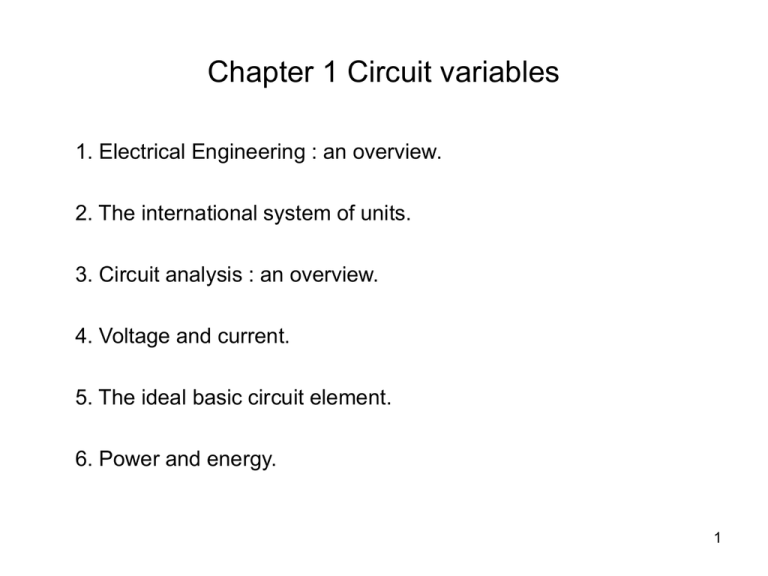Chapter 1 Circuit variables
advertisement

Chapter 1 Circuit variables 1. Electrical Engineering : an overview. 2. The international system of units. 3. Circuit analysis : an overview. 4. Voltage and current. 5. The ideal basic circuit element. 6. Power and energy. 1 Circuit theory • Electric circuit : a mathematical model that approximates the behavior of an actual electrical system. • Circuit theory : a special case of electromagnetic field theory. • Three basic assumptions : 1. Lumped-parameter system : electrical effects happen instantaneously throughout a system. 2. The net charge on every component in the system is always zero. 3. There is no magnetic coupling between the components in a system. 2 Problem solving 1. Identify what’s given and what’s to be found. 2. Sketch a circuit diagram or other visual model. 3. Think of several solution methods and decide on a way of choosing among them. 4. Calculate a solution. 5. Use your creativity. 6. Test your solution. 3 1.2 The international system of units • SI units (six defined quantities) : Table 1.1. • Derived units in SI (defined quantities) : table 1.2. • Standardized prefixes to signify powers of 10 : table 1.3. 4 The international system of units 5 1.3 Circuit analysis : an overview • Conceptual model for electrical engineering design : • Circuit model : a commonly used mathematical model for electrical systems. • Ideal circuit components : the elements that comprise the circuit model. • Circuit analysis : based on mathematical techniques and used to predict the behavior of the circuit model and its ideal circuit components. 6 1.4 Voltage and current • Important characteristics of electric charge : 1. The charge is bipolar, meaning that electrical effects are described in terms of positive and negative charges. 2. The electric charge exists in discrete quantities, which are integral multiples of the electronic charge, 1.6022 1019 C. 3. Electrical effects are attributed to both the separation of charge and charges in motion. • Voltage : the energy per unit charge created by the separation. dw , dq where v the voltage in volts, w the energy in joules, v q the charge in coulombs. 7 Voltage and current • Electric current : the rate of charge flow. dq , dt where i the current in amperes, q the charge in coulmbs, i t the time in seconds. 8 1.5 The ideal basic circuit element • Ideal basic circuit element (Figure 1.5) has three attributes. 1. It has only two terminals, which are points of connection to other circuit components. 2. It is described mathematically in terms of current and/or voltage. 3. It cannot be subdivided into other elements. • Interpretation of reference directions in Fig.1.5 : table 1.4. • Passive sign convention : whenever the reference direction for the current in an element is in the direction of the reference voltage drop across the element (as in Fig. 1.5), use a positive sign in any expression that relates the voltage to the current. Otherwise, use a negative sign. 9 The ideal basic circuit element 10 1.6 Power and energy • Power : time rate of expending or absorbing energy. dw p W(J/s), dt where p the power in watts, w the energy in joules, t the time in seconds. • Power associated with the flow of charge : p dw dw dq vi, dt dq dt where p the power in watts, v the voltage in volts, i the current in amperes. 11 Power and energy • Figure 1.6 passive sign convention ‘If the power is positive (that is, if p>0), power is being delivered to the circuit inside the box. If the power is negative (that is, if p<0), power is being extracted from the circuit inside the box.’ 1.6(b) : i 4 A and v 10 V p vi (10)(4) 40 W. • 1.6(c): i 4 A and v 10 V p vi (10)(4) 40 W. 12





